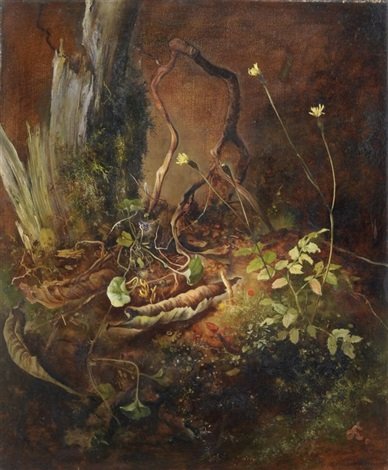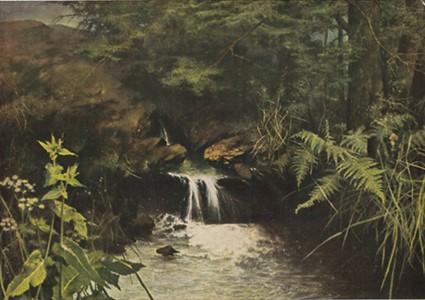Biography from German Art Gallery
Willy Kriegel, ‘The Dürer of our time’
 From 1915 to 1919 German painter Willy Kriegel (1901–1966) worked and studied design-drawing in the art atelier of Reinhold Lorenz in Plauen. After that he studied until 1921 at the Royal Academy of Art with Professor Gross and Professor Baranowski. From 1921 on he studied at the Dresdner Academy with the Professors Ferdinand Dorsch, Otto Gussmann and Otto Hettner; later he was a Master-pupil -with his own atelier- from Oskar Kokoschka. He was influenced by Kokoschka, as well as Otto Dix, but he also painted traditional still lifes and landscapes. His relationship with Gerhard Madaus inspired him to paint botanically correct depictions of plants.
From 1915 to 1919 German painter Willy Kriegel (1901–1966) worked and studied design-drawing in the art atelier of Reinhold Lorenz in Plauen. After that he studied until 1921 at the Royal Academy of Art with Professor Gross and Professor Baranowski. From 1921 on he studied at the Dresdner Academy with the Professors Ferdinand Dorsch, Otto Gussmann and Otto Hettner; later he was a Master-pupil -with his own atelier- from Oskar Kokoschka. He was influenced by Kokoschka, as well as Otto Dix, but he also painted traditional still lifes and landscapes. His relationship with Gerhard Madaus inspired him to paint botanically correct depictions of plants.
Willy Kriegel became a member of the NSDAP in 1933. A year later Kokoschka, the expressionist, had to emigrate to Prague. In 1937 Kriegel took part in the World Exhibition in Paris where he was rewarded with a Gold Medal. On the 30th of March 1941 Joseph Goebbels noted after a meeting with Kriegel: ‘I had an hour meeting with the Dresdner painter Kriegel, the Dürer of our time in the painting of flowers and small animals’. Kriegel was befriended by Magda Goebbels. In 1943 Kriegel received the title of professor.
Twenty-one of his works hung in the Great German Art Ehibitions; Hitler bought 12 of them for prices of up to 25,000 RM (he bought ‘the 4 Parts of the Day’ for 100.000 RM). Other buyers at the GDK were Joachim von Ribbentrop and Joseph Goebbels. In 1944, in the last phase of World War II, Hitler put Kriegel on the Sonderliste of the Gottbegnadetenliste, which named the 12 most important artists (of whom four were painters). However, none of Kriegel’s paintings depicts a Nazi theme; almost all of them were landscapes.
Kriegel was represented with a total of six works at the XX Venice Biennale, 1936 and the XXI Venice Biennale, 1938.
After the war Kriegel lived at Lake Starnberg and worked from 1964 as a professor at the Otto-Klein-Schule in Cologne. Willy Kriegel died in 1964 in Starnberg.
Nowadays the works of Willy Kriegel hang in museums in Berlin, Dresden and Leipzig. Around 20 paintings by Kriegel, many from the 1920s, are in the possession of Schloss Freital near Dresden. ‘Der Eisvogel’ (GDK 1940, room 11) is in the possession of the Bayerische Staatsgemäldesammlungen. In the possession of the Deutsches Historisches Museum are: Trüber Tag (GDK 1941, room 110), ’Sonniger Stein’ (GDK 1941, room 11), ‘Die Quelle’ (GDK 1942, room 15), ‘Ewiger Wald: Waldeinsamkeit’ (GDK 1944, room 4), ‘Am Rande des Waldes’ (GDK 1944, room 4), ‘Wald in der Dämmerung’ (GDK 1944, room 4), ‘Friedlicher Wald’ (GDK 1944, room 4) and ‘Ferner Wald’ (GDK 1944, room 4). All of them are works that Hitler bought at the GDK.
In 2017 (March – May) the exhibition ‘Willy Kriegel, die Dresdner Jahre’, was organized by the Städtische Sammlungen Feital; location Schloss Burgk.
At the end of WWII ‘Die Vier Tageszeiten’ were, with 44 other paintings and 30 statues from Hitler’s private contemporary art collection (and other stolen art collections), hidden by the National Socialists in the Monastery of Hohenfurt (Vyssi Brod), near Linz in the Czech Republic. After the war, valuable art, such as pieces from the Mannheimer- and Rothschild collections, were confiscated by the U.S. Army and taken to the Munich Central Collection Point in an effort to return them to their original owners. Many less valuable works, like contemporary German Nazi-art works, were left behind after the 1945 liberation of Czechoslovakia and ended up scattered across the country. In 2012 sixteen paintings by German artists – that Adolf Hitler personally purchased during WWII – were found in various Czech institutions. Seven were discovered in the Zákupy Chateau in the Czech Republic. After the war the Zákupy Chateau was the site where items from confiscated castles, chateaus and private houses were gathered. Seven other artworks were found at the convent of Premonstratensian Sisters in Doksany, near Prague. Two others were found at the Military Institute in Prague and at the Faculty of Law of Charles University in Prague.
‘Die Vier Tagenszeiten’ was found in the Zákupy Chateau. Unfortunately one of Kriegel’s four paintings -‘The Morning’- was not found back and is still missing. The three other paintings are now in the possession of the ‘Czech National Institute for the Protection and Conservation of Monuments and Sites’. They will remain in the Czech Republic.
Renegade Editor’s Note: Thanks to NS Europa for introducing me to this artist.




















Source Article from http://www.renegadetribune.com/willy-kriegels-paintings-natures-beauty/
Related posts:
Views: 0
 RSS Feed
RSS Feed

















 April 1st, 2018
April 1st, 2018  Awake Goy
Awake Goy  Posted in
Posted in  Tags:
Tags: 
















